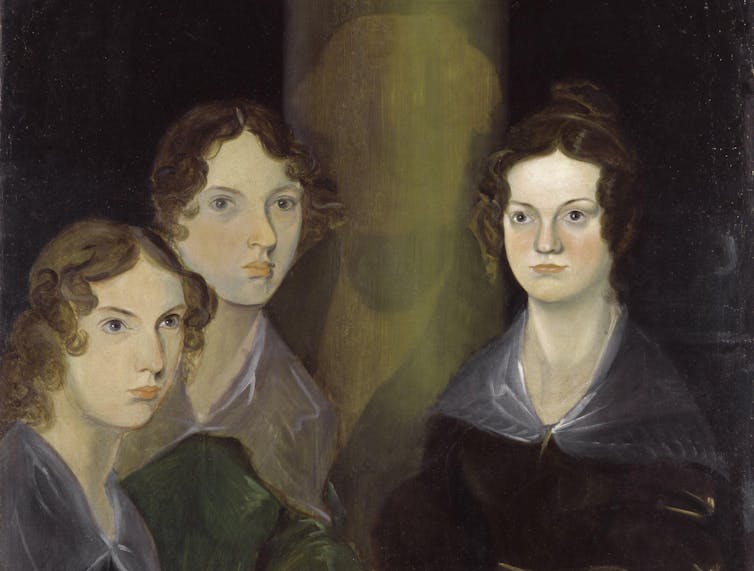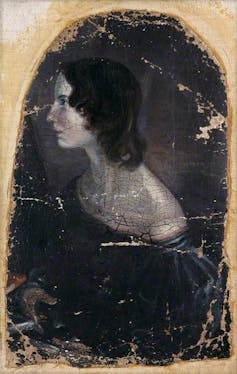
National Portrait Gallery/Wikimedia
Amber Pouliot, Harlaxton College
To this day, Emily Brontë’s life story and literature continue to exert a powerful hold on the imaginations of audiences worldwide. One reason for the longevity of this fascination is the air of mystery that envelops the author and her work. Who was Emily Brontë? What does her famous novel, Wuthering Heights, mean? And how could a reclusive curate’s daughter, living on the edge of the Yorkshire moors, have written this mysterious tale of passion and revenge?
In 1896, literary critic Clement Shorter dubbed Emily “the sphinx of our modern literature”. She died early, leaving behind only a few diary papers and letters, in addition to her novel and poetry. By contrast, we have volumes of letters from her sister Charlotte, telling us about her life in her own words. Emily was private, reclusive, and difficult to understand. But the strength of collective desire to uncover who she really was, and how she came to create her masterpiece, inadvertently also gave rise to one of the coarsest and most curious legends to have attached itself to the Brontë family – the myth that Wuthering Heights was the product of incestuous longings.

National Portrait Gallery, London, CC BY-NC-ND
In Wuthering Heights, the relationship between Heathcliff and Cathy defies easy labels. Adopted by old Mr Earnshaw, Heathcliff is raised alongside Cathy, sharing her lessons, games, and even her bed. It’s no wonder, then, that Cathy’s desire to marry Heathcliff and her declaration of love and affinity – “he’s more myself than I am. Whatever our souls are made of, his and mine are the same” – sometimes throws readers. Are they siblings? Are they lovers? Are they both? Cathy and Heathcliff might be “kin”, but as academic Mary Jean Corbett explains, there is no indication in the text that their relationship is prohibited on the grounds of brother-sister incest.
Still, seeming to take their cue from Cathy and Heathcliff’s relationship, biographers and creative writers have characterised the relationship between Emily and her brother Branwell as particularly close. As early as 1883, A. Mary F. Robinson argued that Wuthering Heights could be explained if one looked into Emily’s relationship with Branwell. Later, during the interwar period, as the Brontës’ lives became the subject of acknowledged works of fiction and drama, that sibling bond was sexualised and offered as an explanation for the novel.
In some of these texts, Branwell and Emily’s relationship is sexually abusive. In Ella Moorhouse’s Stone Walls (1936), for instance, Branwell tries to force a knife and bottle of liquor into Emily’s mouth. In others, it is loving and supportive. Clemence Dane’s play, Wild Decembers (1932), features a fictional Branwell indulging in masturbatory fantasies while looking at his sister. But he also supports Emily’s writing and collaborates with her to bring Wuthering Heights – their symbolic child – into the world.

Wikimedia
There are a number of texts that simply revel in the salaciousness of imagining sibling love, too. In Kathryn Jean MacFarlane’s Divide the Desolation (1936), Emily and Branwell engage in a form of childhood S&M play, with Emily delighting in the fact that her brother cares enough to hurt her. While Emilie and Georges Romieu’s The Brontë Sisters (1931) features an extended erotic fantasy in which Emily pulls Branwell from his burning bed and against her body while wearing a translucent, wet night gown.
In each of these texts, Emily’s relationship with Branwell is presented as the catalyst for Wuthering Heights. Sexually charged moments between the siblings are often followed by scenes in which Emily commits her brother’s words and actions to paper. Some of these texts even dramatise the siblings writing the novel together, and Branwell is often given Heathcliff’s lines.
But why did this incestuous idea enter the minds of other writers in the first place? Many of the Brontës’ first readers characterised their writing as coarse, which isn’t surprising. Heathcliff abuses wives and animals, uses brutal language, and digs up the body of his dead lover, after all. When Elizabeth Gaskell approached the task of writing The Life of Charlotte Bronte (1857) , she needed to excuse this perceived coarseness, to stress the sisters’ respectability, but also explain how they created characters like Heathcliff.
Gaskell resolved her difficulties by claiming the sisters misguidedly recorded the coarse behaviour of their brother, Branwell, a man who suffered from addiction and mental illness following the end of a disastrous relationship. Branwell, according to Gaskell, was the model for Heathcliff, Rochester, Huntingdon. During the interwar period, in the heyday of psychoanalysis, some writers took Gaskell at her word. If the brutal but sexually alluring Heathcliff was Emily’s portrait of her brother, then perhaps their relationship was the model for Cathy and Heathcliff’s.
![]() Quite apart from the fact that we have no evidence for incest in the Brontë family, the incest myth is problematic because it makes Branwell ultimately responsible for Wuthering Heights. It reduces Emily from a spontaneous genius or deliberate artist to a woman grappling with forbidden desires or subject to sexual abuse. Let’s hope that in the year of her bicentenary, Emily’s genius will finally be allowed to stand on its own.
Quite apart from the fact that we have no evidence for incest in the Brontë family, the incest myth is problematic because it makes Branwell ultimately responsible for Wuthering Heights. It reduces Emily from a spontaneous genius or deliberate artist to a woman grappling with forbidden desires or subject to sexual abuse. Let’s hope that in the year of her bicentenary, Emily’s genius will finally be allowed to stand on its own.
Amber Pouliot, Teaching fellow, British Studies, Harlaxton College
This article was originally published on The Conversation. Read the original article.




You must be logged in to post a comment.